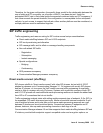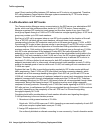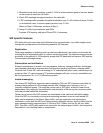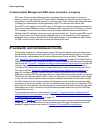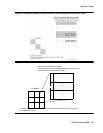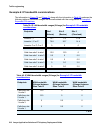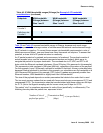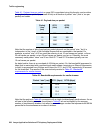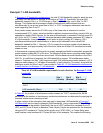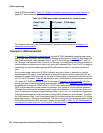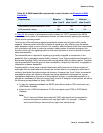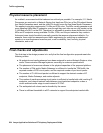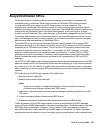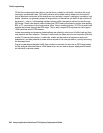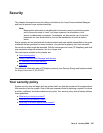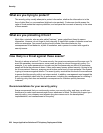
Resource sizing
Issue 6 January 2008 221
Example 7: LAN bandwidth
In Example 6: IP bandwidth considerations, the total IP LAN bandwidth usage for each site was
calculated, and expressed in Erlangs at the bottom of Table 39
. Specifically, the total LAN
bandwidth usage in Site 1 is 123.5 Erlangs, in Site 2 is 56.6 Erlangs, and in Site 3 is 29.2
Erlangs. This implies that the average number of bidirectional media streams that are
simultaneously in use at any given time in Site 1 is 123.5. Analogous statements can also be
made regarding Sites 2 and 3.
Every media stream across the IP LAN in any of the three sites is assumed to use the
uncompressed G.711 codec, since bandwidth is relatively inexpensive within a private LAN, as
opposed to a public WAN. Assume, for the sake of this example, a standard IP packet size of 20
ms. So for the G.711 codec, Table 42
indicates that each media stream consumes 87.2 kbps of
IP LAN bandwidth. It may be tempting at this point to simply multiply 87.2 kbps by 123.5
simultaneous bidirectional media streams, to arrive at the estimate for the overall LAN
bandwidth needed for Site 1. However, 123.5 is merely the average number of simultaneous
media streams, and approximately half of the time, there are at least 124 simultaneous media
streams in use.
In this example, suppose that the goal is to supply enough bandwidth to adequately support the
media streams at least 99.9% of the time. The standard infinite-server queueing model implies
that less than 0.1% of the time there are at least 159 simultaneous media streams in the Site 1
LAN. So, it is sufficient to engineer the LAN bandwidth to support 158 simultaneous media
streams. Therefore, the Site 1 LAN requires at least (158 simultaneous media streams) x (87.2
kbps per media stream) = 13.8 Mbps of bandwidth, in each direction. This result, along with the
analogous results for Sites 2 and 3, are provided in Table 43:
IP LAN bandwidth requirements
in each direction, for Example 7: LAN bandwidth.
In Table 43
, the number of simultaneous media streams for “P001” represents the 99.9th
percentile for the number of simultaneous unidirectional streams, as determined by applying the
standard infinite-server queueing model.
A slight variation of the procedure that was used to determine LAN bandwidth in Example 7:
LAN bandwidth can be used to determine WAN bandwidth. Using compressed RTP (cRTP) is a
means to conserve bandwidth. Specifically, the use of cRTP reduces the overhead due to IP,
UDP, and RTP from 40 bytes to between 2 and 4 bytes (4 bytes are assumed for this example).
Using the PPP overhead of 7 bytes (which would vary if ATM, HDLC, or Frame Relay were
used) implies a total overhead of 11 bytes (88 bits) in this example. This implies the following
Table 43: IP LAN bandwidth requirements in each direction, for Example 7: LAN
bandwidth
Resource Site 1
(Atlanta)
Site 2
(Boston)
Site 3
(Cleveland)
Simultaneous media streams for
“P001”
158 81 47
LAN bandwidth (Mbps) 13.8 7.1 4.1



